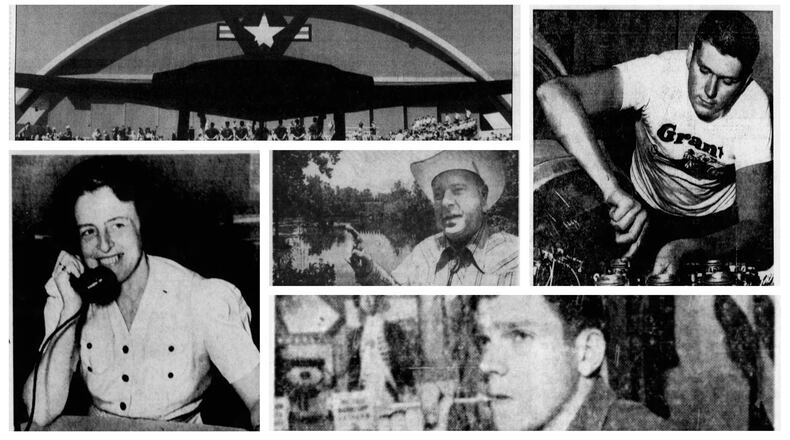Here’s a look at some stories happening the week of July 16-22.
July 17, 1938: Wright Field attaché one of America’s few women in aeronautical engineering
Every month, M. Elsa Gardner would edit and condense about 600 scientific magazine articles written in German, French and Italian as well as English in order to share the information with American soldiers.
Her official position was Editor of the Technical Data Digest, which was a semi-monthly publication distributed to all air corps branches and interested aircraft manufacturers.
Along with a mathematics degree, she picked up French, German, Greek and Latin at St. Lawrence University. She taught herself Italian after that. Later, she studied machine design during night classes at New York University. While there, she received a scholarship to MIT to study aeronautical engineering.
At MIT, she worked with wind tunnels and in the engine testing laboratory, as well as in welding, riveting and woodwork.
Based at Wright Field, she was one of only a handful of women aeronautical engineers in America.
While working for the Wright Aeronautical Corp. she helped write the instruction manual for the widely used Wright Cyclone motor.
She was the only woman member of the Dayton Engineers Club and one of only 14 women who belonged to the American Society of Mechanical Engineers.
Said to be a woman of “unbelievable capabilities,” almost no public acclaim had been given to her despite her vast contributions.
July 16, 1950: Intelligence tests keep half of Dayton volunteers from Armed Forces service.
Military recruitments were of interest in 1950 as hostilities grew at the start of the Korean War.
Intelligence tests were part of the initial screening of military candidates. The tests, said to be geared “for average men with eighth grade schooling,” were eliminating about 52 percent of applicants in Dayton.
Army and Air Force recruiters in Dayton pointed out that only about 40 percent of the men who take their intelligence tests were able to pass it. Marine recruiters had a similar story while Navy recruiters said 50 percent were passing their test.
A25 minutes were given to take the 45-question “screening” test. One recruiter said it was “really not very difficult, but a lot of men become excited and this hurts their score.”
July 19, 1963: Quiet, please! Mayor racing
Being a mayor didn’t detour Darrell Harris from a hobby that most public office-holders might avoid.
The 25-year-old Riverside mayor was devoted to the sport of drag racing. He was even entered as a driver the the national drag racing meet at Indianapolis that summer.
Harris was elected mayor when no one ran for mayor and he ended up with two write-in votes. At first, he declined the $300-a-year job, but then reconsidered.
Riverside had a population of 270 at the time.
When asked about his hobby, Harris said, “People have the wrong idea of drag racing. When it is supervised and done on a proper track, it’s safer than normal highway driving.”
Harris, who still lived at home with his parents, said his biggest fear about being mayor was running “Mayor’s court.”
But after gaining some experience, he said he was having thoughts about running for re-election.
July 20, 1975: Huber developer opposes annexation, incorporation
The man almost solely responsible for the development of Huber Heights, Charles Huber, was opposed to the City of Dayton annexing the area.
He was also opposed to incorporation, but expected that area of Wayne Twp. to eventually become a city.
Referring to the township trustee form of government that was in place, Huber said, “If I pick up the phone and call the police or fire department, they’ll be here within minutes. What can an annexation off the people except a higher tax bill?”
Of incorporation, Huber said, “I don’t like it either, but I can live with it.”
Huber hoped the Huber name would be used for any future city. But at that point, the most frequently mentioned potential name for the area was “Waynetown.”
The City of Huber Heights was incorporated on Jan. 23, 1981.
July 17, 1983: Herle’s downtown extensively damaged by fire
Herle’s clothing store in downtown Dayton was the scene of a major fire in 1983.
Damage was listed at $1.2 million.
Dispatchers ignored the first call and delayed sending fire trucks for 11 minutes over confusion on if the reported smoke was from a fire or fog from an exterminator spraying for moths.
Eleven engines and five fire trucks eventually responded to the four-story building located on East Third Street near Jefferson Street. A decorative metal facade covering the face of the building made fighting the fire more difficult.
Among the many spectators at the scene were Mayor Paul Leonard and City Commissioner Abner Orick.
The cause of the fire was unknown.
July 18, 1991: Stealth fighter lands at Air Force Museum
A Stealth Fighter test model landed at the Air Force Museum to become a display piece.
Looking like a sharp black arrowhead, the jet sliced through a hazy sky upon approach, making several passes over the museum grounds.
Development of the jet during the 1970s and 1980s was a secret. The Air Force didn’t acknowledge the stealth program until 1988.
The YF-117A radar-evading jet that dropped bombs on Baghdad was presented by an Air Force General to museum officials during an outdoor ceremony.
Museum director Richard Uppstrum called the new addition a “truly extraordinary event. To think that less than three years ago w did not talk about the F-117.”
The airplane was on display outdoors for about a week before it moved to its permanent indoor display where visitors were given unrestricted access to the plane.
About the Author







